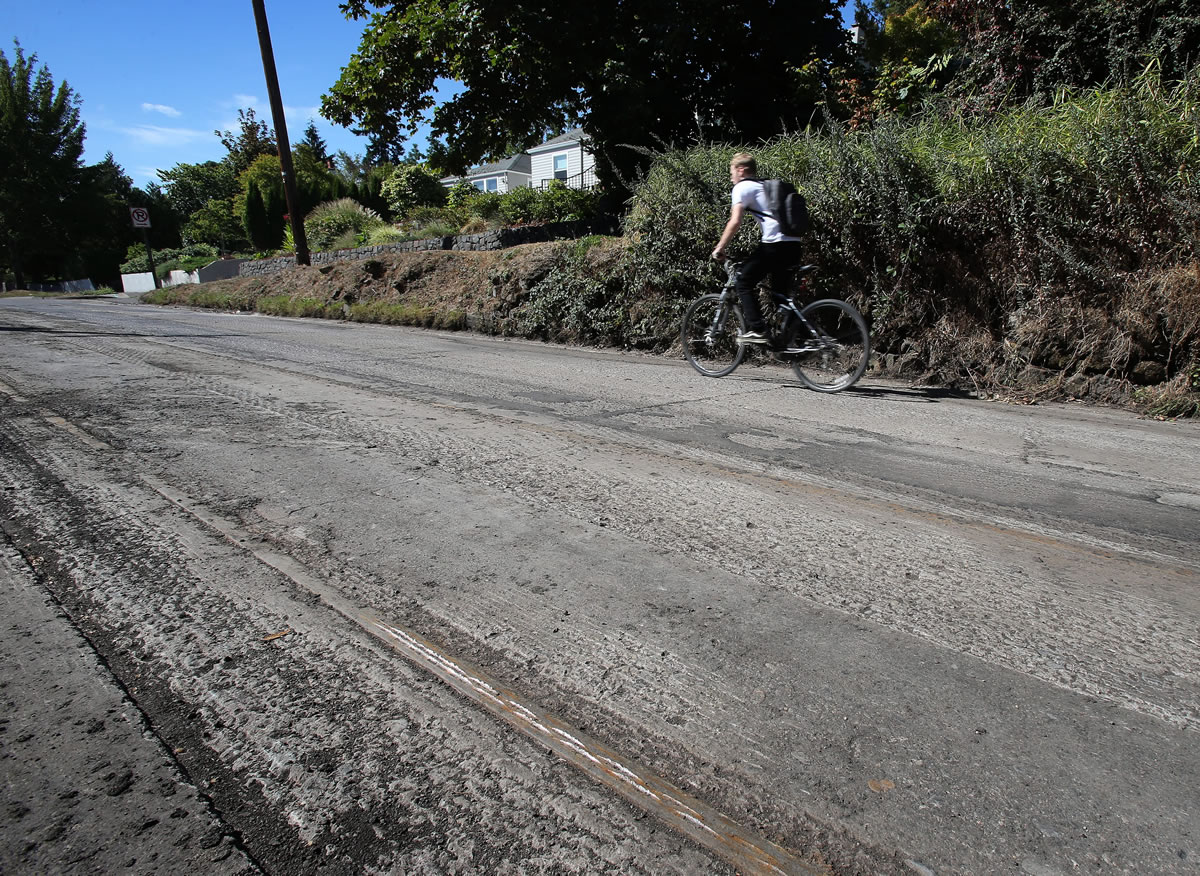EUGENE, Ore. — A work crew scraping cracked pavement off Willamette Street last week — using a spinning drum studded with teeth — hit on a piece of Eugene history.
The equipment lost some teeth on streetcar rails long buried in the pavement, part of a system that was the fastest and most comfortable way to get around in Eugene during the World War I era.
The rediscovered rails — along Willamette between 19th and 23rd avenues — are encased in concrete and not expected to be rescued.
Nor is their discovery so unusual. Every couple of years, a worker will similarly uncover part of the 18 miles of track that once branched through the city, from Willamette Street to River Road and from West 11th Avenue to Springfield.
And whenever the daylight strikes the metal of an old rail, it seems to set rail enthusiasts to dreaming — of the past, when the streetcar shaped the development of Eugene, and of a future when they imagine the clang of a streetcar bell returning to Willamette Street.
The discoveries prompt news stories, public speeches and, sometimes, feasibility studies. In Eugene, the idea never seems to go away, said Tom Schwetz, a planning manager at Lane Transit District.
“I’ve been here for 27 years, and I’ve constantly heard people bemoaning the lack of streetcars,” Schwetz said. “(It’s) like, ‘What’s wrong with this community that it doesn’t have a streetcar system?'”
Eugene got its first electric streetcar line in 1907, when the Portland, Eugene & Eastern Co. took out a franchise to use the roads from the city and put down the first rail.
City streets were dirt at the time, pocked by animal hooves, said Robert Krebs, a former Oregon Department of Transportation intercity rail coordinator and a current member of the Salem Transit Board.
It was a slog for University of Oregon students to get downtown. And developers platting the outskirts were eager for the boost in property values that a streetcar route would bring.
The Morning Oregonian headlined the grand opening of the line: “Eugene Becomes City in Reality.”
Soon, the city wanted more. By Sept. 22, 1909, an impatient editorial in The Eugene Daily Guard groused at PE&E, saying that the city could “not much longer grow and expand” without the system placing the suburbs in touch with the business center — and the matter was important enough for the Commercial Club to take on.
It was a period of phenomenal growth for Eugene, according to Michelle Dennis, a historic preservation consultant. Department stores had arisen in the downtown retail district. Thirty-five new business blocks and stores were constructed.
“You didn’t want to ride a horse if you worked in an office,” Krebs said.
By the mid-1920s, streetcar companies were trading in rails for rubber-tired buses. They were private, for-profit companies, Krebs said, that “had to maintain the tracks and the overhead wire — and they had to pay a franchise fee to the city to be on city property,” he said. “By converting to buses, they used the streets for almost free.”
In the 90 years since, all but a few feet of track were covered over by repeated repaving — and then, as the streets failed and the subsurface had to be repaired, crews began digging up the old rails encased in asphalt or concrete beneath the cracked pavement.
But it’s not just history. Three years ago, for instance, the call resurfaced for a revitalized streetcar system in Eugene. Cities all over the country are recreating streetcar lines, led by Portland, which reintroduced streetcars in 2001.
“In Portland, it’s used as an economic development tool,” Schwetz said. “It’s stimulating redevelopment of areas that have become slums — or old railroad yards. The Pearl District used to be an old railyard.”
Portland figures it has seen $3.5 billion in private investment within 750 feet of its four-mile route, according to a recent report.
In Eugene, meanwhile, the Eugene Streetcar Feasibility Study Group met for a year to discuss the possibilities here. The group included representatives from PeaceHealth, UO, Lane County, city of Eugene, LTD, Eugene Water & Electric Board, Lane Council of Governments, the Eugene Chamber of Commerce and Travel Lane County.
The group’s report, issued in March 2011, concluded that Eugene was not yet ready for a streetcar.
But the report’s executive summary began with what seems an eternal truth.
“Streetcars are cool!” the report said.



